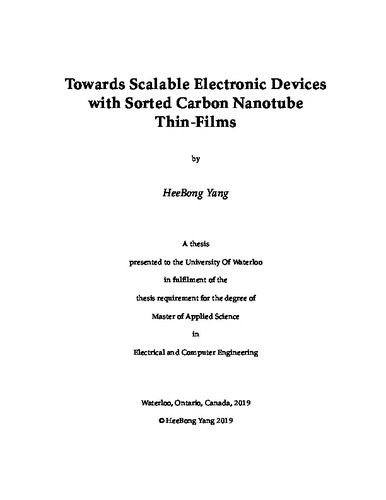| dc.contributor.author | Yang, HeeBong | |
| dc.date.accessioned | 2020-01-07 19:26:54 (GMT) | |
| dc.date.available | 2020-01-07 19:26:54 (GMT) | |
| dc.date.issued | 2020-01-07 | |
| dc.date.submitted | 2019-12-19 | |
| dc.identifier.uri | http://hdl.handle.net/10012/15420 | |
| dc.description.abstract | The year 2021 is the 30th anniversary of carbon nanotube (CNT) discovery in 1991
by Sumio Iijima. CNTs, a cylindrical hollow shape, exhibit fascinating electrical and
optical properties. CNTs have been at the heart of the fundamental research and engineering
applications in various studies last three decades. Especially, CNTs are attractive
because they have unique electronic structures which show different band gap
energy as a function of their size. Nevertheless, we face two serious technical challenges
with regards creating large-scale electronic and photonic devices using CNTs. First, we
need to solve a sorting problem to extract a specific size of CNTs. Second, we have to
control the alignment and orientation of sorted CNTs. Here, we present research progresses
to master a sorting technique and to form an aligned CNT thin-film followed by
device fabrication and characterization of sorted films.
We decide to apply aqueous two-phase extraction (ATPE) method to purify various
CNT synthesis sources. ATPE shows strong advantages in scalability and relatively
simple and low-cost processing steps over other methods. We manage to achieve high
purity metallic and semiconducting CNTs in large volumes. We attempt a vacuum filtration
method to make thin-films with sorted CNT solutions for devices. Although we
need a transferring step to place films on substrates, we enjoy the flexibility to choose a
variety of substrate form factors with size and thickness control.
In order to characterize electrical performance of CNT films, we fabricate planar
two-terminal devices using different sizes of metallic and semiconducting CNT films
with and without alignment. We examine the film quality and basic electrical performance
via DC resistance and low frequency noise properties from temperaturedependent
measurements. Our lessons are that aligned CNT film devices behave better
than other conditions in terms of smaller resistance and more linear-like current-voltage
characteristics at low temperatures. All film devices follow the 1/f noise behavior and
we will pursue further quantitative assessment of their noise properties in depth. We
envision that we will make high performance quantum devices based on sorted CNT
thin-films. | en |
| dc.language.iso | en | en |
| dc.publisher | University of Waterloo | en |
| dc.subject | carbon nanotubes | en |
| dc.subject | aqueous two-phase extraction | en |
| dc.subject | 1/f noise | en |
| dc.subject | thin-film electronics | en |
| dc.title | Towards Scalable Electronic Devices with Sorted Carbon Nanotube Thin-Films | en |
| dc.type | Master Thesis | en |
| dc.pending | false | |
| uws-etd.degree.department | Electrical and Computer Engineering | en |
| uws-etd.degree.discipline | Electrical and Computer Engineering | en |
| uws-etd.degree.grantor | University of Waterloo | en |
| uws-etd.degree | Master of Applied Science | en |
| uws.contributor.advisor | Kim, Na Young | |
| uws.contributor.affiliation1 | Faculty of Engineering | en |
| uws.published.city | Waterloo | en |
| uws.published.country | Canada | en |
| uws.published.province | Ontario | en |
| uws.typeOfResource | Text | en |
| uws.peerReviewStatus | Unreviewed | en |
| uws.scholarLevel | Graduate | en |

